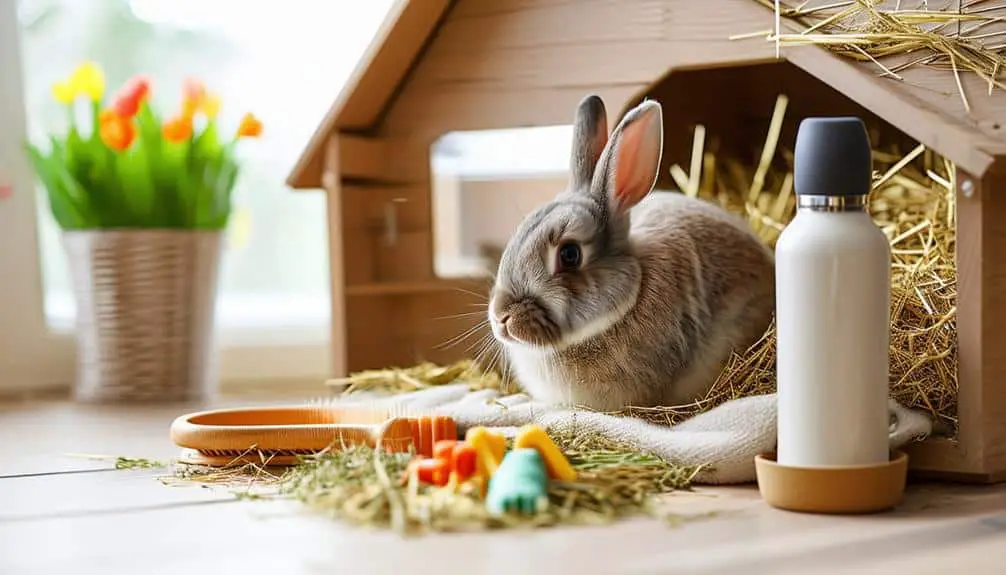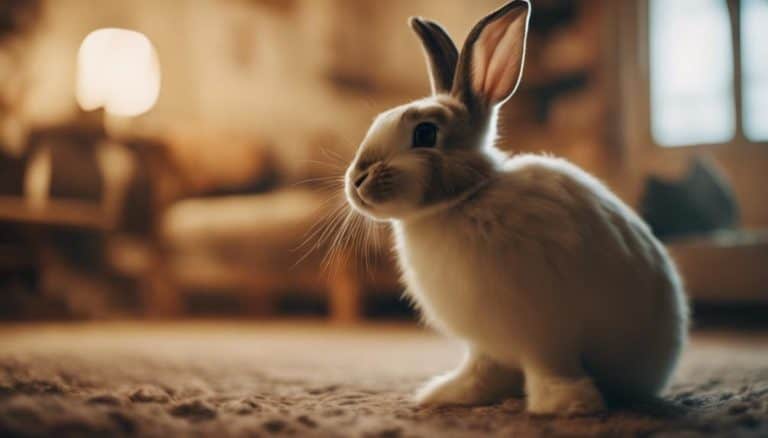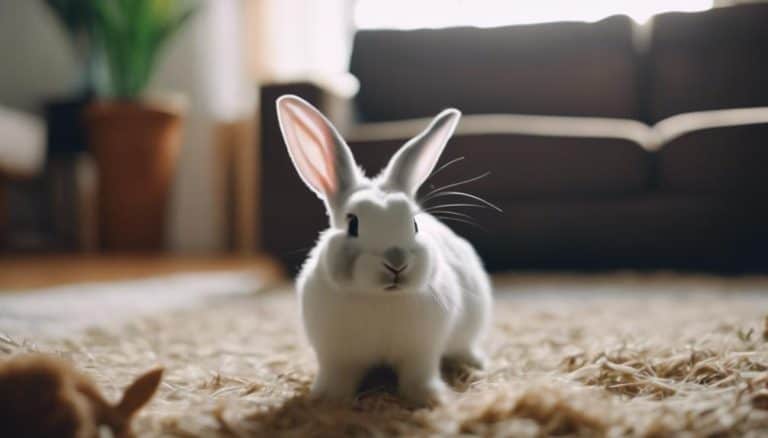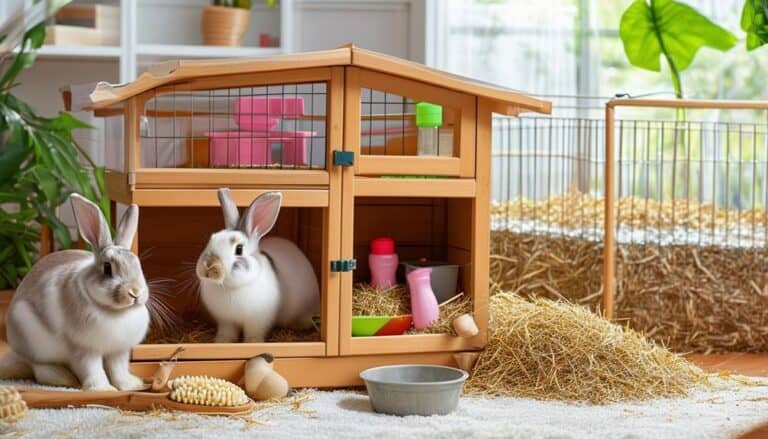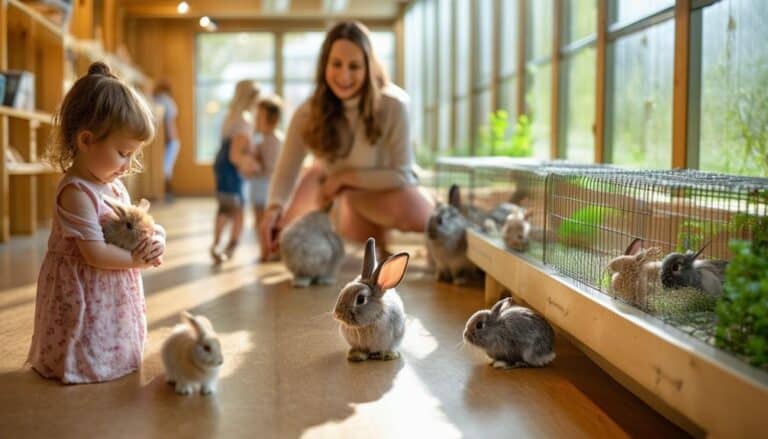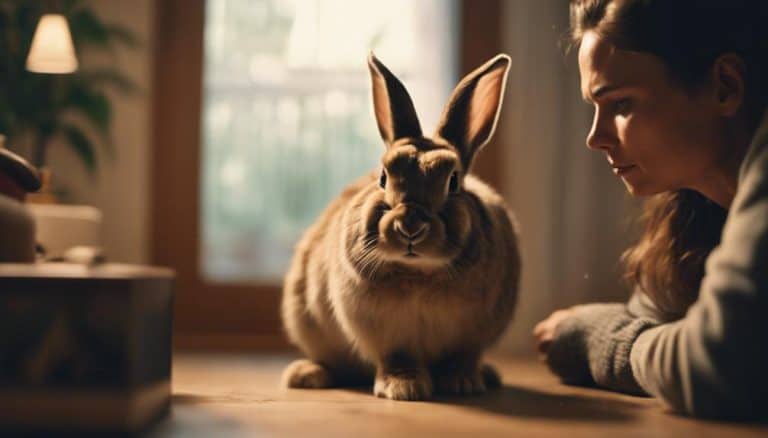7 Must-Have Necessities for New Pet Rabbit Owners
When bringing a new pet rabbit into our homes, we need several essentials to guarantee their well-being.
First, a spacious and secure enclosure is critical. Sturdy food and water bowls, placed strategically, keep their diet and hydration consistent. Low-entry, spacious litter boxes with rabbit-safe litter are necessary. Providing high-quality hay and safe veggies supports their nutrition. Toys and enrichment items like chew toys and tunnels keep them mentally engaged.
Grooming supplies such as a slicker brush and nail clippers maintain their hygiene. Finally, essential health care items like styptic powder and a first aid kit are indispensable. Let’s explore these further.
Housing

When setting up housing for our new pet rabbit, a spacious and secure enclosure that includes distinct areas for eating, resting, and using the litter box is essential. A well-designed rabbit habitat should provide enough room for our rabbit to hop, stretch, and stand comfortably. The enclosure must avoid wire-bottom floors to prevent foot injuries; instead, we should opt for solid surfaces covered with soft bedding to guarantee comfort.
Our rabbit’s habitat should be located in a quiet area, away from drafts, direct sunlight, and household hazards. This will create a peaceful environment that mimics their natural conditions. To enhance mental stimulation, we need to enrich the habitat with toys, tunnels, and platforms. These elements offer not only physical exercise but also mental engagement, keeping our rabbit happy and healthy.
Moreover, we should ensure that the enclosure is escape-proof, as rabbits are known for their curiosity and agility. Regular inspection of the habitat for wear and tear is crucial to maintain its integrity.
Food and Water Bowls
To safeguard our rabbit’s well-being, we must carefully choose sturdy food and water bowls that prevent tipping and maintain stability. Selecting heavy ceramic or stainless steel bowls ensures they won’t easily be knocked over, keeping our rabbit’s environment clean and safe. The importance of these bowls for maintaining a consistent feeding and hydration routine, essential for our rabbit’s health.
We should place hay near the food and water bowls to encourage natural foraging behavior. Using hay feeders can help keep the hay clean and easily accessible, promoting a healthy diet. Hay is an essential part of a rabbit’s nutrition, and ensuring it remains uncontaminated is key. Proper placement of these bowls and feeders helps establish a predictable environment, which is beneficial for our rabbit’s sense of security.
Additionally, constant access to fresh water is non-negotiable. We should use a clean water bottle alongside the bowls to ensure our rabbit stays hydrated. Regularly checking and refilling the water bottle prevents dehydration, which can lead to serious health issues.
Litter Boxes and Litter
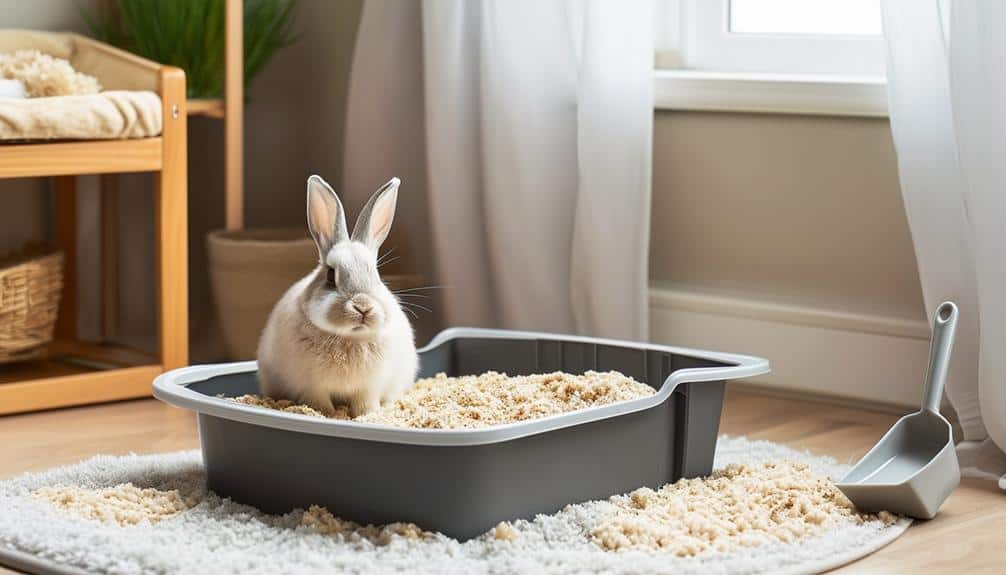
When selecting litter boxes for our rabbits, it’s important to choose the right size and safe litter types like paper-based or compressed hardwood pellets.
We should strategically place the boxes in their habitat and regularly clean them to maintain a hygienic environment.
If we encounter litter training issues, adjusting the placement or trying different litter can help.
Choosing the Right Size
Choosing a litter box that’s spacious enough for your rabbit to move around comfortably and access easily is essential for maintaining their hygiene and comfort. When selecting a litter box, we should choose one that accommodates our rabbit’s size, offering ample room for them to turn around without restriction. Triangular or corner litter boxes capitalize on rabbits’ natural preference for eliminating in corners, making them a practical choice.
For ease of entry and exit, a litter box with a low entry point is important, especially for younger or older rabbits. This feature guarantees our rabbit can use the litter box without any physical strain, promoting consistent use.
To further encourage proper litter habits, placing multiple litter boxes strategically around their habitat is highly recommended. This provides convenience and reinforces good behavior, especially in larger enclosures.
We should also consider the type of litter we use. Rabbit-safe options like paper-based or aspen shavings are effective at absorbing odors and moisture, enhancing overall cleanliness.
With these considerations in mind, selecting the right size and type of litter box becomes a straightforward task, ensuring our rabbits enjoy a hygienic and comfortable living environment.
Types of Litter
Choosing the appropriate type of litter for our rabbit’s litter box is essential for their health and comfort. Rabbits litter choices should prioritize safety and functionality. Opt for paper-based, wood, or compressed pelleted litter. These materials are highly absorbent and non-toxic, ensuring our rabbit’s environment remains clean and safe.
On the other hand, avoid clay or clumping cat litter; if ingested, they can cause gastrointestinal blockages and other health issues for our rabbits.
Strategically placing at least two litter boxes in our rabbit’s habitat can greatly encourage good litter habits. This setup provides our furry friend with accessible options, promoting consistent use.
It’s also beneficial to add hay to the litter box. Rabbits naturally like to nibble while relieving themselves, making hay an excellent addition that encourages proper use of the litter box for both urination and defecation.
Cleaning and Maintenance
Maintaining a clean litter box is essential for the health and well-being of our pet rabbit, requiring daily scooping of waste and regular changes of litter to prevent odors and bacteria buildup.
To guarantee proper waste management, we should place at least two litter boxes in our rabbit’s habitat. This not only provides our rabbit with multiple options but also helps keep their living environment clean and hygienic.
Choosing the right type of litter is vital. We should opt for safe and absorbent options like paper-based or wood pellets, which are excellent for odor control. These materials aren’t only effective at soaking up moisture but are also gentle on our rabbit’s sensitive paws.
Encouraging our rabbit to use the litter boxes involves placing urine-soaked hay or droppings inside the boxes. This familiar scent will guide them to associate the boxes with toileting. Proper litter box training is crucial to maintain cleanliness and hygiene.
Hay and Fresh Veggies
Let’s turn our focus to the critical components of hay and fresh veggies in our rabbit’s diet. We’ll explore the types of hay suitable for different life stages, identify safe vegetables, and offer portion control tips to guarantee balanced nutrition.
Types of Hay
For new rabbit owners, it’s important to understand the different types of hay available, as each type serves specific dietary needs.
Timothy hay is highly recommended for adult rabbits due to its high fiber content and low sugar levels. This combination supports healthy digestion and prevents obesity, making it a staple in a rabbit’s diet. The fibrous texture also helps wear down their continually growing teeth, which is vital for dental health.
For those of us with rabbits that have Timothy hay allergies, orchard grass hay is an excellent alternative. It provides similar benefits regarding fiber content and palatability, ensuring our rabbits receive the necessary nutrients without compromising their health.
Young rabbits and pregnant or nursing mothers have different nutritional requirements. Alfalfa hay is ideal for these groups because it’s rich in calcium and protein, which are important for growth and milk production. However, due to its high calcium content, alfalfa hay should be limited for adult rabbits to prevent urinary issues.
Understanding these distinctions allows us to tailor our rabbit’s diet to their specific needs, ensuring they thrive in our care. By providing the right type of hay, we can promote excellent health and longevity for our furry companions.
Safe Fresh Veggies
In addition to providing the right type of hay, we must incorporate safe fresh veggies into our rabbit’s diet to guarantee they receive a well-rounded nutritional profile.
Fresh veggies are indispensable, offering essential vitamins and hydration that hay alone can’t supply. Leafy greens, such as romaine lettuce, kale, and parsley, should form the bulk of our rabbit’s fresh veggie intake. These greens provide important nutrients and fiber, aiding in digestive health and preventing obesity.
Carrots and herbs like cilantro and basil can also be included but should be given in moderation due to their higher sugar content. The key is variety; a diverse diet ensures that our rabbit gets a complete range of vitamins and minerals.
However, introducing new veggies gradually is critical. This allows us to monitor any adverse reactions, such as diarrhea or gas, and adjust accordingly.
Fresh veggies should complement the hay, which should constitute 80% of their diet. The remaining 20% can be fresh veggies, ensuring our rabbit maintains excellent health and vitality.
Portion Control Tips
Proper portion control of hay and fresh veggies is crucial to maintaining our rabbit’s health and preventing digestive issues. Our rabbit will have access to unlimited timothy hay, making up 80% of their diet. This high-fiber hay is essential for their digestive system and dental health, ensuring they stay active and happy.
When it comes to fresh veggies, we need to be meticulous. While these greens are an important part of their diet, they should be given in controlled amounts. A general guideline is to offer about one cup of vegetables per two pounds of body weight daily. This guarantees our rabbit gets the necessary nutrients without overwhelming their digestive system.
We should rotate the types of veggies to provide a balanced intake of vitamins and minerals, and always introduce new veggies gradually to monitor for any adverse reactions.
Avoid sugary mixes and stick to fresh, leafy greens alongside the timothy hay. This combination helps in maintaining a balanced diet. Remember, consistency is key.
Proper portion control of hay and fresh veggies ensures our rabbit will have access to all the nutrients they need for a healthy life.
Toys and Enrichment
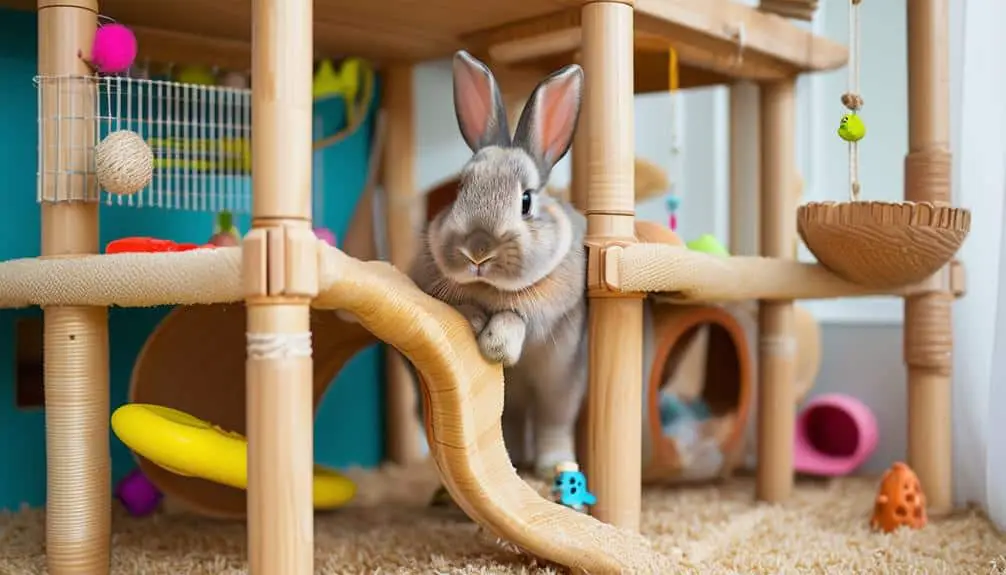
Ensuring your pet rabbit has access to a variety of toys and enrichment activities is vital for their mental and physical well-being. Rabbits need stimulation to prevent boredom and promote healthy behaviors. Chew toys, tunnels, and balls provide excellent avenues for physical activity and mental engagement.
Specifically, items like wooden blocks, willow balls, and seagrass mats cater to their natural chewing instincts, helping to maintain dental health.
To further enrich their environment, we can introduce digging boxes, cardboard tubes, and hiding spots. These elements offer opportunities for play and exploration, essential for a rabbit’s curious nature.
Interactive toys such as treat dispensers and foraging puzzles not only entertain but also encourage exercise and problem-solving skills, reducing the likelihood of behavioral issues.
It’s important to rotate these toys regularly. By changing up their playthings, we prevent monotony and keep our rabbits continually engaged. This practice ensures a stimulating environment, essential for their overall well-being.
Let’s remember, a well-enriched environment isn’t just a necessity—it’s a requirement for any rabbit’s happiness and health. By providing a variety of toys and activities, we’re fostering a life full of freedom and discovery for our furry friends.
Grooming Supplies
Regular grooming is essential for maintaining your rabbit’s health and well-being. It helps prevent fur matting, overgrown nails, ear infections, and other health issues. To guarantee our rabbits remain clean and comfortable, we need to invest in several grooming supplies.
| Grooming Tool | Purpose |
|---|---|
| Slicker Brush | Removes loose fur, prevents mats |
| Nail Clippers | Trims overgrown nails |
| Ear Cleaner | Cleans ears, prevents infections |
| Toothbrush | Maintains dental hygiene |
| Rabbit-Safe Shampoo | Gentle cleaning, skin protection |
Using a slicker brush regularly helps us manage our rabbit’s shedding and prevents fur from matting. Nail clippers are essential for trimming overgrown nails that can cause discomfort or injury. Ear cleaner ensures our rabbit’s ears remain free from discharge and potential infections. A toothbrush helps in maintaining dental hygiene, which is important as dental issues can be common in rabbits.
For bathing, a rabbit-safe shampoo is non-negotiable. Ordinary shampoos can irritate a rabbit’s sensitive skin, so we must choose a shampoo specifically formulated for rabbits. By adhering to a regular grooming routine tailored to our rabbit’s breed, age, and health, we can safeguard their overall well-being and foster a stronger bond with our furry companion.
Health Care Items

Health care items are crucial for monitoring and maintaining our rabbit’s overall well-being. Essential tools include nail clippers and styptic powder. By regularly trimming their nails, we prevent overgrowth and injury, while styptic powder helps stop any accidental bleeding.
Grooming our rabbit with a brush and comb not only reduces shedding but also allows us to check for any skin issues or parasites.
Maintaining a clean rabbit habitat is essential for our pet’s health. White vinegar is a natural and effective cleaner that helps maintain hygiene and eliminate odors without exposing our rabbit to harsh chemicals. A whisk broom and dustpan are indispensable for swift cleanups of any accidents, ensuring the living space remains tidy and safe.
A well-stocked first aid kit is a must-have for every rabbit owner. It should include supplies like antiseptic wipes, gauze, and bandages to handle minor injuries and health concerns promptly. Having these items on hand can make a significant difference in an emergency, providing immediate care until we can consult with a veterinarian.
Conclusion
To conclude, ensuring our new pet rabbit thrives requires thoughtful preparation. By providing proper housing, suitable food and water bowls, and an appropriate litter setup, we lay the foundation for a healthy environment.
Integrating hay, fresh veggies, and engaging toys enriches their daily life. Grooming supplies and essential health care items further safeguard their well-being.
With these necessities in place, we’re equipped to offer our rabbit a happy, enriching, and healthy home.

